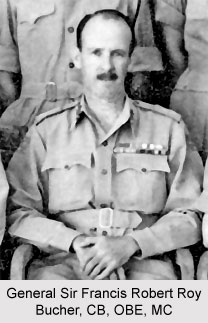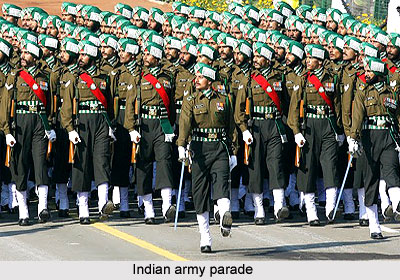 The independence of India brought about a huge change in the formation, structure and size of the Indian Army after Independence. The Indian Army, after independence, represented the Indian society as a whole, unlike most of the imperial armies. However, after independence it retained one of the British Army officers, named General Bucher, as the Chief of Army Staff (COAS) throughout its first war with Pakistan, until 15 January 1949. He was replaced by the first ever Indian COAS, General Cariappa. Following the partition of India, the level of violence had reached civil war proportions and had to be contained rapidly. It was a grave price to pay for India`s independence, although the Armed Forces of both India and Pakistan provided yeoman service in arresting further bloodshed and ensuring smooth exchange of service personnel opting for either India or Pakistan.
The independence of India brought about a huge change in the formation, structure and size of the Indian Army after Independence. The Indian Army, after independence, represented the Indian society as a whole, unlike most of the imperial armies. However, after independence it retained one of the British Army officers, named General Bucher, as the Chief of Army Staff (COAS) throughout its first war with Pakistan, until 15 January 1949. He was replaced by the first ever Indian COAS, General Cariappa. Following the partition of India, the level of violence had reached civil war proportions and had to be contained rapidly. It was a grave price to pay for India`s independence, although the Armed Forces of both India and Pakistan provided yeoman service in arresting further bloodshed and ensuring smooth exchange of service personnel opting for either India or Pakistan.
The Punjab Boundary Force came into being for this thankless task. It had elements of the Armies of both countries spread thinly on the ground, and was hard put to contain the increasing levels of violence. This was to be the last time that the old Indian Army deployed jointly as one body. After six weeks of continuous violence, peace gradually returned. While uniting the loosely federated Princely States and Indian Provinces into one homogeneous entity, some initial difficulties were encountered. Except for three, most of the 566 odd Princely States merged with India in accordance to the laid down directives.
Military Organisation of Indian Army after Independence
The military organisation of the Indian Army after independence was not that much different from that of the British period and the regiments and battalions of the Indian Army were selected according to their respective castes. The Indian Army has also successfully separated itself from the Indian society following a number of ways. The main objective behind this separation was to help the soldiers perform its military missions properly in the face of growing tensions in Indian society. The rank-and-file soldiers in the Indian infantry have not been recruited from demographic areas of India as a whole, and they contain deliberately constructed clusters of sub-castes. The Government of India is in charge of the Indian Army and the government recruits the Army officer corps selectively and the officer corps is not representative of the Indian population. If the combination of the patterns of recruitment, training, and deployment in rank-and-file soldiers and in the officer corps of the Indian Army is taken together, it would create such an army that is characterised by many small military communities.
Recruitment of Soldiers in Indian Army after Independence
The Indian government recruited the soldiers in the Indian Army for a period of seven years until the year of 1977 and after 1977; the soldiers were recruited for a term of seventeen years. The Military Training Directorate is in charge of recruiting soldiers in the Indian Army on behalf of the government and in 1984, it used to select recruits from among those who volunteered. The selection of the soldiers was mainly based on a physical exam of the volunteer. No intelligence test, no aptitude test or no other test was taken of the applicants for judging their abilities. However, after some years, the Military Training Directorate introduced intelligence testing for screened recruits and it was introduced mainly because of the massive oversubscription of vacancies in the infantry.
After recruiting a person into the Indian Army, the Army officials make him go through a period of basic training that is lengthier in comparison to that of the Western armies. This training is provided mainly because of the need to bring the person up to some minimum standards of health and education. The Basic Training of Indian Army was extended from thirty-six to fifty-two weeks in the early 1980s with a view to include a sixteen-week Pre-Basic training. The main objective of the Pre-Basic training was to enable the newly recruited person to qualify for up to third class certificate of education and map reading. There were also requirements for meeting the need for basic literacy and physical conditioning before the army could introduce the recruited person to soldiering. A large portion of the need for Pre-Basic training was related to literacy and the recruited people would admit that they were illiterate and attend literacy classes in the army, before the 1970s. After the 1970s, a number of recruits started to come into the army with the equivalent of American high school diplomas. However, eventually the Military Training Directorate put all recruits through Pre-Basic training.
 Once the Basic Training is completed, the Indian Army officials were used to provide some additional training to the soldiers. In the 1950s, this training was composed primarily of close-order drill. The soldiers were also provided an individual training of thirty-five to forty-two days every year, and another thirty days in field training with their units. After completing the entire training process, the soldiers of the Indian Army are kept occupied with routine tasks and mechanical drill with the other soldiers in their unit for seventeen years. Generally, the Indian soldiers are routinely deployed in peacetime to army stations in the hills for years with short breaks. The normal tour for a soldier in a high-altitude station is around four years, and the soldier goes for duty at a peace station, for a period of two years. If summed up, almost half to two-third of an Indian soldier`s total is in the field areas.
Once the Basic Training is completed, the Indian Army officials were used to provide some additional training to the soldiers. In the 1950s, this training was composed primarily of close-order drill. The soldiers were also provided an individual training of thirty-five to forty-two days every year, and another thirty days in field training with their units. After completing the entire training process, the soldiers of the Indian Army are kept occupied with routine tasks and mechanical drill with the other soldiers in their unit for seventeen years. Generally, the Indian soldiers are routinely deployed in peacetime to army stations in the hills for years with short breaks. The normal tour for a soldier in a high-altitude station is around four years, and the soldier goes for duty at a peace station, for a period of two years. If summed up, almost half to two-third of an Indian soldier`s total is in the field areas.
There are four kinds of forces operating in the Indian Army at the moment and the forces include the Regular Army, the Army Reserve, the Territorial Army and the National Cadet Corps. Headquartered in New Delhi, the Indian Army operated its functions under the Chief of Army Staff (COAS), and he is responsible for the command, control and administration as a whole. There are six operational commands (field armies) and one training command in the Indian Army and each of them operates under the command of a Lieutenant General. The Lieutenant General has an equal status to the Vice-Chief of Army Staff (VCOAS). The Operation Commands of Indian Army are named as the Northern Command, Western Command, South Western Command, Eastern Command, Southern Command and the Central Command. The Army Training Command is headquartered in Shimla, Himachal Pradesh.
After Independence further changes were introduced. The Indian President became the Supreme Commander of the armed forces. The three Services heads were designated the Chief of the Army Staff, Chief of the Naval Staff and Chief of the Air Staff. The title `Royal` awarded to the Indian Navy and Indian Air Force and all other units of the army earlier was dropped on 26th January, 1950. The Indian Army is now the senior of the three services. The Defence Committee of the Cabinet deals with all important policy matters relating to defence.






